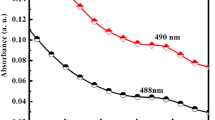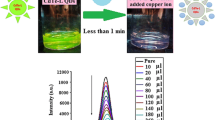Abstract
In the present work, we have developed a rapid, cost-effective aqueous phase route to synthesize water-soluble Thioglycolic acid (TGA) capped CdSe/ZnS (CdSe/ZnS + TGA) QD sensor. Synthesized QD sensor has been successfully validated its candidature for the efficient detection of hazardous heavy metal ions (Xn+) specifically chromium (Cr3+) and copper (Cu2+) in aqueous medium. In the presence of Xn+ metal ions, ‘‘Turn-Off’’ fluorescence response is observed due to the complex formation (Xn+: CdSe/ZnS + TGA). A strong 1:1 complexation (Xn+: CdSe/ZnS + TGA) between QD sensor and Xn+ metal ion is confirmed by the output of Benesi–Hildebrand relation and Job’s plot. As per our knowledge our proposed CdSe/ZnS + TGA QD sensor has established its efficient sensing capability for metal ions with lower detection of limit (LOD) up to concentration ~ 10–7 M for the first time which is lower than permissible limit as per WHO data. The practical application of this system for determining metal ions in real samples has also been successfully demonstrated.
Graphical Abstract










Similar content being viewed by others
Data availability
The datasets generated during and/or analysed during the current study are available from the corresponding author on reasonable request.
References
J.A. Cotruvo, WHO guidelines for drinking water quality: first addendum to the fourth edition. J. Am. Water Works Assoc. 109(7), 44–51 (2017)
D. Sanchez-Rodas, W. Corns, B. Chen, P. Stockwell, Atomic fluorescence spectrometry: a suitable detection technique in speciation studies for arsenic, selenium, antimony and mercury. J. Anal. At. Spectrom. 25(7), 933–946 (2010). https://doi.org/10.1039/B917755H
S. Wu, N.C. Sekar, S.N. Tan, H. Xie, S.H. Ng, Determination of chromium (III) by differential pulse stripping voltammetry at a chitosan–gold nanocomposite modified screen printed electrode. Anal. Methods 8(5), 962–967 (2016). https://doi.org/10.1039/C5AY03291A
K. Chullasat, P. Nurerk, P. Kanatharana, F. Davis, O. Bunkoed, A facile optosensing protocol based on molecularly imprinted polymer coated on CdTe quantum dots for highly sensitive and selective amoxicillin detection. Sens. Actuators B Chem. 254, 255–263 (2018). https://doi.org/10.1016/j.snb.2017.07.062
M. Ishikawa, V. Biju, Luminescent quantum dots, making invisibles visible in bioimaging. Prog. Mol. Biol. Transl. Sci. 104, 53–99 (2011). https://doi.org/10.1016/B978-0-12-416020-0.00002-4
P. Chowdhury, Functionalized CdTe fluorescence nanosensor for the sensitive detection of water borne environmentally hazardous metal ions. Opt. Mater. 111, 110584 (2021). https://doi.org/10.1016/j.optmat.2020.110584
M. Rana, P. Chowdhury, L-glutathione capped CdSeS/ZnS quantum dot sensor for the detection of environmentally hazardous metal ions. J. Lumin. 206, 105–112 (2019). https://doi.org/10.1016/j.jlumin.2018.10.060
M. Rana, A. Jain, V. Rani, P. Chowdhury, Glutathione capped core/shell CdSeS/ZnS quantum dots as a medical imaging tool for cancer cells. Inorg. Chem. Commun. 112, 107723 (2020). https://doi.org/10.1016/j.inoche.2019.107723
N. Beloglazova, P. Shmelin, E. Speranskaya, B. Lucas, C. Helmbrecht, D. Knopp, R. Niessner, S. De Saeger, I.Y. Goryacheva, Quantum dot loaded liposomes as fluorescent labels for immunoassay. Anal. Chem. 85(15), 7197–7204 (2013). https://doi.org/10.1021/ac401729y
Z. Hu, R. Xia, S. Kais, A quantum algorithm for evolving open quantum dynamics on quantum computing devices. Sci. Rep. 10(1), 3301 (2020). https://doi.org/10.1038/s41598-020-60321-x
A. Badawi, N. Al-Hosiny, S. Abdallah, S. Negm, H. Talaat, Tuning photocurrent response through size control of CdTe quantum dots sensitized solar cells. Sol. Energy 88, 137–143 (2013). https://doi.org/10.1016/j.solener.2012.11.005
M. Rana, P. Chowdhury, Studies on size dependent structures and optical properties of CdSeS clusters. J. Cluster Sci. 31, 1111–1121 (2020). https://doi.org/10.1007/s10876-019-01719-0
M.A. Malik, P. O’Brien, N. Revaprasadu, A simple route to the synthesis of core/shell nanoparticles of chalcogenides. Chem. Mater. 14(5), 2004–2010 (2002). https://doi.org/10.1021/cm011154w
R. Freeman, T. Finder, I. Willner, Multiplexed analysis of Hg2+ and Ag+ ions by nucleic acid functionalized CdSe/ZnS quantum dots and their use for logic gate operations. Angew. Chem. 121(42), 7958–7961 (2009). https://doi.org/10.1002/ange.200902395
X. Sun, X. Huang, J. Guo, W. Zhu, Y. Ding, G. Niu, A. Wang, D.O. Kiesewetter, Z.L. Wang, S. Sun, Self-illuminating 64Cu-doped CdSe/ZnS nanocrystals for in vivo tumor imaging. J. Am. Chem. Soc. 136(5), 1706–1709 (2014). https://doi.org/10.1021/ja410438n
B. Suo, X. Su, J. Wu, D. Chen, A. Wang, Z. Guo, Poly (vinyl alcohol) thin film filled with CdSe–ZnS quantum dots: fabrication, characterization and optical properties. Mater. Chem. Phys. 119(1–2), 237–242 (2010). https://doi.org/10.1016/j.matchemphys.2009.08.054
E. Oh, R. Liu, A. Nel, K.B. Gemill, M. Bilal, Y. Cohen, I.L. Medintz, Meta-analysis of cellular toxicity for cadmium-containing quantum dots. Nat. Nanotechnol. 11(5), 479–486 (2016). https://doi.org/10.1038/nnano.2015.338
S.S. Talmage, Environmental and human safety of major surfactants: alcohol ethoxylates and alkylphenol ethoxylates, 1st edn. (CRC Press, Boca Raton, 2020). https://doi.org/10.1201/9780138757199
W.E. Mahmoud, A.M. Al-Amri, S. Yaghmour, Low temperature synthesis of CdSe capped 2-mercaptoethanol quantum dots. Opt. Mater. 34(7), 1082–1086 (2012). https://doi.org/10.1016/j.optmat.2012.01.001
X. Wei, M. Meng, Z. Song, L. Gao, H. Li, J. Dai, Z. Zhou, C. Li, J. Pan, P. Yu, Synthesis of molecularly imprinted silica nanospheres embedded mercaptosuccinic acid-coated CdTe quantum dots for selective recognition of λ-cyhalothrin. J. Lumin. 153, 326–332 (2014). https://doi.org/10.1016/j.jlumin.2014.03.055
H.F. Wu, J. Gopal, H.N. Abdelhamid, N. Hasan, Quantum dot applications endowing novelty to analytical proteomics. Proteomics 12(19–20), 2949–2961 (2012). https://doi.org/10.1002/pmic.201200295
H.N. Abdelhamid, H.-F. Wu, Selective biosensing of Staphylococcus aureus using chitosan quantum dots. Spectrochim. Acta A Mol. Biomol. Spectrosc. 188, 50–56 (2018). https://doi.org/10.1016/j.saa.2017.06.047
P. Diwan, A. Bharadwaj, Nanomedicine (Pentagon Press, Shahpur Jat, 2006)
S. Subramanian, S. Ganapathy, M. Rajaram, A. Ayyaswamy, Tuning the optical properties of colloidal quantum dots using thiol group capping agents and its comparison. Mater. Chem. Phys. 249, 123127 (2020). https://doi.org/10.1016/j.matchemphys.2020.123127
L. Guerrini, R.A. Alvarez-Puebla, N. Pazos-Perez, Surface modifications of nanoparticles for stability in biological fluids. Materials 11(7), 1154 (2018). https://doi.org/10.3390/ma11071154
G. Jocelin, A. Arivarasan, M. Ganesan, N.R. Prasad, G. Sasikala, Synthesis of colloidal quantum dots coated with mercaptosuccinic acid for early detection and therapeutics of oral cancers. Int. J. Nanosci. 15(04), 1650015 (2016). https://doi.org/10.1142/S0219581X16500150
P. Yadav, P. Chowdhury, Optical efficiency of CdTe QDs for metal ion sensing in the presence of different thiol-based capping agents. Chem. Pap. (2022). https://doi.org/10.1007/s11696-021-01991-3
L. Li, Y. Lu, Y. Ding, F. Zhang, Y. Wang, Facile aqueous synthesis of functionalized CdTe nanoparticles and their application as fluorescence probes for determination of adenine and guanine. Can. J. Chem. 90(2), 173–179 (2012). https://doi.org/10.1139/v11-144
P. Dagtepe, V. Chikan, J. Jasinski, V.J. Leppert, Quantized growth of CdTe quantum dots; observation of magic-sized CdTe quantum dots. J. Phys. Chem. C 111(41), 14977–14983 (2007). https://doi.org/10.1021/jp072516b
L. Spanhel, M. Haase, H. Weller, A. Henglein, Photochemistry of colloidal semiconductors. 20. Surface modification and stability of strong luminescing CdS particles. J. Am. Chem. Soc. 109(19), 5649–5655 (1987). https://doi.org/10.1021/ja00253a015
S. Sharma, P. Chowdhury, Fluorescence signal from carbon quantum dots synthesized from natural resources. Mater. Today Proc. (2023). https://doi.org/10.1016/j.matpr.2023.05.676
R. Snyder, S. Hsu, S. Krimm, Vibrational spectra in the C H stretching region and the structure of the polymethylene chain. Spectrochim. Acta A Mol. Biomol. Spectrosc. 34(4), 395–406 (1978). https://doi.org/10.1016/0584-8539(78)80167-6
M.S. Abd El-Sadek, J. Ram Kumar, S. Moorthy Babu, Optical properties of thiol-stabilised CdTe nanoparticles. Int. J. Nanopart. 2(1–6), 20–29 (2009). https://doi.org/10.1504/IJNP.2009.028730
M. Pal, N. Mathews, P. Santiago, X. Mathew, A facile one-pot synthesis of highly luminescent CdS nanoparticles using thioglycerol as capping agent. J. Nanopart. Res. 14, 1–13 (2012). https://doi.org/10.1007/s11051-012-0916-3
C.Y. Huang, Enzyme kinetics and mechanism—part c: intermediates, stereochemistry, and rate studies. Meth. Enzymol. 87, 509–525 (1982). https://doi.org/10.1016/s0076-6879(82)87029-8
H.A. Benesi, J. Hildebrand, A spectrophotometric investigation of the interaction of iodine with aromatic hydrocarbons. J. Am. Chem. Soc. 71(8), 2703–2707 (1949). https://doi.org/10.1021/ja01176a030
Y. Ding, S.Z. Shen, H. Sun, K. Sun, F. Liu, Synthesis of L-glutathione-capped-ZnSe quantum dots for the sensitive and selective determination of copper ion in aqueous solutions. Sens. Actuators B Chem. 203, 35–43 (2014). https://doi.org/10.1016/j.snb.2014.06.054
M. Koneswaran, R. Narayanaswamy, RETRACTED: l-Cysteine-capped ZnS quantum dots based fluorescence sensor for Cu2+ ion. Sens. Actuators B Chem. 131(1), 104–109 (2009). https://doi.org/10.1016/j.snb.2008.09.028
T. Han, H. Kang, S. Ye, Y. Yuan, Y. Zhang, L. Dong, Ultra-stable fluorescent film sensor based on quantum dots for the real-time detection of Cu2+. Sci. Total. Environ. 746, 141412 (2020). https://doi.org/10.1016/j.scitotenv.2020.141412
S. Chaudhary, S. Kumar, B. Kaur, S. Mehta, Potential prospects for carbon dots as a fluorescence sensing probe for metal ions. RSC Adv. 6(93), 90526–90536 (2016). https://doi.org/10.1039/C6RA15691F
S.K. Raj, A. Rajput, H. Gupta, R. Patidar, V. Kulshrestha, Selective recognition of Fe3+ and Cr3+ in aqueous medium via fluorescence quenching of graphene quantum dots. J Dispers Sci. Technol. 40(2), 250–255 (2019). https://doi.org/10.1080/01932691.2018.1467775
Funding
This research received no specific grant from any funding agency in the public, commercial, or not-for-profit sectors.
Author information
Authors and Affiliations
Contributions
Shruti Sharma: data curation, visualization, investigation, software, validation, writing—reviewing and editing. Pooja Yadav: writing—original draft preparation, data curation visualization, investigation, writing—reviewing and editing. Papia Chowdhury: conceptualization, software, methodology, supervision.
Corresponding author
Ethics declarations
Competing interests
The authors declare that they have no known competing financial interests that could have appeared to influence the work reported in this paper.
Additional information
Publisher's Note
Springer Nature remains neutral with regard to jurisdictional claims in published maps and institutional affiliations.
Rights and permissions
Springer Nature or its licensor (e.g. a society or other partner) holds exclusive rights to this article under a publishing agreement with the author(s) or other rightsholder(s); author self-archiving of the accepted manuscript version of this article is solely governed by the terms of such publishing agreement and applicable law.
About this article
Cite this article
Sharma, S., Yadav, P. & Chowdhury, P. Thioglycolic acid capped CdSe/ZnS quantum dot as fluorescent sensor for the detection of water-soluble hazardous heavy metal ions. Appl. Phys. A 130, 326 (2024). https://doi.org/10.1007/s00339-024-07491-x
Received:
Accepted:
Published:
DOI: https://doi.org/10.1007/s00339-024-07491-x




